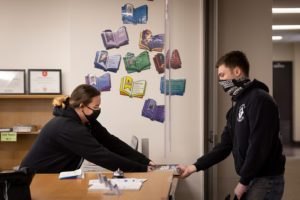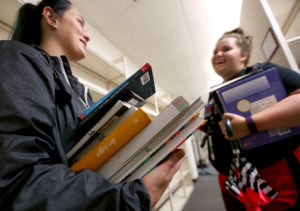In the battle to make textbooks more affordable, many colleges and universities are starting to explore the idea of including the cost in students’ tuition and fees. For some, it involves a model known as “Inclusive Access” that has been promoted by the textbook industry but comes with several challenges for students and faculty.
Is there a way to include textbook costs in tuition and fees while putting students’ interests first?
Enter the University of Wisconsin-Stout. It has included textbook rentals into the price of tuition for more than a century, working closely with librarians and students.
 The university has staff dedicated to finding the most affordable learning materials for students – providing a sustainable model that sidesteps unpredictable, sky-rocketing prices. The university is also expanding its use of open educational resources (OER) to help keep costs down.
The university has staff dedicated to finding the most affordable learning materials for students – providing a sustainable model that sidesteps unpredictable, sky-rocketing prices. The university is also expanding its use of open educational resources (OER) to help keep costs down.
Each semester, the Instructional Resources Service at UW-Stout charges students a set rental fee for print and digital textbooks, access codes, CDs and other materials for its courses.Students pay $13.15 per credit hour—on average, $315 per year—for textbook fees that are rolled into tuition.
The university estimates that its model saved the students of UW-Stout roughly $4.5 million last year.
“It’s really affordable compared to what students are paying at other institutions—and there is so much less hassle,” says Devin Dumke, president of the Stout Student Association. “It’s one reason why a lot of students come here. We tell prospective students they don’t have to buy textbooks at all, they’re included in your tuition—that’s a real win for folks.”
To save students money, staff from Instructional Resources can negotiate bulk pricing with vendors and discuss alternative digital or Open Educational Resource materials with faculty members. For traditionally published materials, the office owns the books and distributes them like a library, getting as much life as possible and then selling them to the used book market. When selecting resources, the university doesn’t commit to any single publisher—always shopping for the best deals.
“At our institution, Instructional Resources is really doing the advocacy for us,” says Dumke.
Textbook affordability has been part of the school’s tradition for years. UW-Stout was founded in 1879 as a training school with the belief that students shouldn’t have extra costs to get the education they need to go into the workforce.
 Each year, Robert Butterfield, director of UW-Stout’s Instructional Resources, coordinates those efforts. He proposes the textbook rental fee to the student senate, which has input into the recommendations. Once approved, the fee is set for the academic year.
Each year, Robert Butterfield, director of UW-Stout’s Instructional Resources, coordinates those efforts. He proposes the textbook rental fee to the student senate, which has input into the recommendations. Once approved, the fee is set for the academic year.
“Our job is to find whatever means that we can to maintain low-costs and stabilize that cost so it’s one less concern that our students have to fund their college,” he says.
From 2016 to 2021, the textbook fee decreased by 12.5 percent twice and remained the same for three years. It is anticipated that inflation will force the fee to increase by 3 percent to $13.54 per credit hour next year–still Dumke maintains, well below what students pay at other peer institutions.
When Butterfield came in 2011, all materials were in print. Now, about 70 percent are digital and 30 percent are print.
Much of the course material Stout uses is technical and not available in open formats, but the university’s goal is to convert 5-10 percent of its content to OER, Butterfield says. His office is working with faculty who can serve as OER ambassadors to encourage others to switch to open formats, saving students even more.
“It’s an extra financial burden for students to be purchasing and then reselling their books. This rental system at UW Stout works quite well for the faculty and for the students in terms of keeping costs down, and keeping the accessibility without too much of a cost to these resources,” says Alan Scott, professor of physics at UW-Stout.
Faculty are encouraged not to change books every semester and use an e-textbook, when available. As an author of textbooks himself, Scott says he’d like to sell his intellectual property but recognizes the change afoot. “I understand that education is kind of moving in a different direction—to make things equitable across the world and make it open,” he says.
Butterfield works with collection development staff in the library to track digital usage of materials, flagging items for faculty to reconsider requiring if students are not accessing them. His office has also negotiated life-time access for about 70 percent of digital materials it made available for students, so they can use them in graduate school and beyond.
If this is such a good deal for students, why don’t more colleges follow this model?
“Because it’s hard,” Butterfield says. “It’s kind of daunting because there are so many pieces. We do encourage other campuses to take it a bit at a time. The worst thing you can do is nothing at all.”